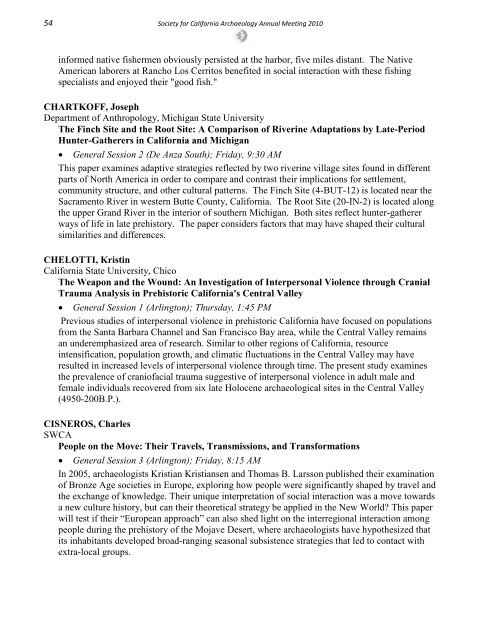Society for California Archaeology 2010 Annual Meeting
Society for California Archaeology 2010 Annual Meeting
Society for California Archaeology 2010 Annual Meeting
Create successful ePaper yourself
Turn your PDF publications into a flip-book with our unique Google optimized e-Paper software.
54 <strong>Society</strong> <strong>for</strong> Cali<strong>for</strong>nia <strong>Archaeology</strong> <strong>Annual</strong> <strong>Meeting</strong> <strong>2010</strong><br />
in<strong>for</strong>med native fishermen obviously persisted at the harbor, five miles distant. The Native<br />
American laborers at Rancho Los Cerritos benefited in social interaction with these fishing<br />
specialists and enjoyed their "good fish."<br />
CHARTKOFF, Joseph<br />
Department of Anthropology, Michigan State University<br />
The Finch Site and the Root Site: A Comparison of Riverine Adaptations by Late-Period<br />
Hunter-Gatherers in Cali<strong>for</strong>nia and Michigan<br />
• General Session 2 (De Anza South); Friday, 9:30 AM<br />
This paper examines adaptive strategies reflected by two riverine village sites found in different<br />
parts of North America in order to compare and contrast their implications <strong>for</strong> settlement,<br />
community structure, and other cultural patterns. The Finch Site (4-BUT-12) is located near the<br />
Sacramento River in western Butte County, Cali<strong>for</strong>nia. The Root Site (20-IN-2) is located along<br />
the upper Grand River in the interior of southern Michigan. Both sites reflect hunter-gatherer<br />
ways of life in late prehistory. The paper considers factors that may have shaped their cultural<br />
similarities and differences.<br />
CHELOTTI, Kristin<br />
Cali<strong>for</strong>nia State University, Chico<br />
The Weapon and the Wound: An Investigation of Interpersonal Violence through Cranial<br />
Trauma Analysis in Prehistoric Cali<strong>for</strong>nia's Central Valley<br />
• General Session 1 (Arlington); Thursday, 1:45 PM<br />
Previous studies of interpersonal violence in prehistoric Cali<strong>for</strong>nia have focused on populations<br />
from the Santa Barbara Channel and San Francisco Bay area, while the Central Valley remains<br />
an underemphasized area of research. Similar to other regions of Cali<strong>for</strong>nia, resource<br />
intensification, population growth, and climatic fluctuations in the Central Valley may have<br />
resulted in increased levels of interpersonal violence through time. The present study examines<br />
the prevalence of craniofacial trauma suggestive of interpersonal violence in adult male and<br />
female individuals recovered from six late Holocene archaeological sites in the Central Valley<br />
(4950-200B.P.).<br />
CISNEROS, Charles<br />
SWCA<br />
People on the Move: Their Travels, Transmissions, and Trans<strong>for</strong>mations<br />
• General Session 3 (Arlington); Friday, 8:15 AM<br />
In 2005, archaeologists Kristian Kristiansen and Thomas B. Larsson published their examination<br />
of Bronze Age societies in Europe, exploring how people were significantly shaped by travel and<br />
the exchange of knowledge. Their unique interpretation of social interaction was a move towards<br />
a new culture history, but can their theoretical strategy be applied in the New World? This paper<br />
will test if their “European approach” can also shed light on the interregional interaction among<br />
people during the prehistory of the Mojave Desert, where archaeologists have hypothesized that<br />
its inhabitants developed broad-ranging seasonal subsistence strategies that led to contact with<br />
extra-local groups.

















